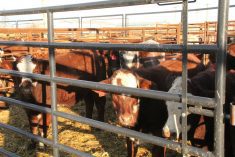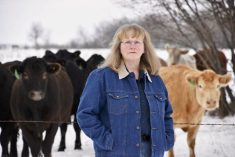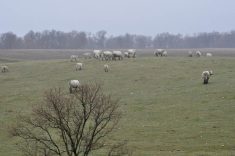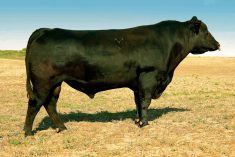“I thought it would be better this year. I’d say it’s worse now than it was in 2003. That year, calf prices weren’t all that bad.”
– ART DENBOW
he fall calf run, delayed a few weeks by an abundance of rain that kept pastures green later than usual, has
begun.
A regular cattle sale on Wednesday of
last week at Heartland Auction Services in Virden saw 1,200 head go through the ring, with 500-to 600-pound steers averaging $1.03 with the top hitting $1.10. Steers in the 650-pound range were bringing 91 to 95 cents.
Read Also

Pig transport stress costs pork sector
Popular livestock trailer designs also increase pig stress during transportation, hitting at meat quality, animal welfare and farm profit, Agriculture and Agri-Food Canada researcher says
The mood in the bleachers was less than festive, despite the overnight dump of snow which made it feel like Christmas.
“Finished cattle are right in the toilet. Seventy-two cents last week for finished steers,” said Art Denbow, an Oak Lake-area rancher with 115 cows. “The grain market has crashed, too.”
He recalled that it wasn’t too many years ago when 800-pound cattle were bringing $1.20 a pound. At the sale last week, that class was bringing just 90 to 92 cents.
Denbow was surprised by the unusually strong market for old bulls, which were bringing just 20 cents a pound less than finished steers.
COUNTING ON PENSION CHEQUES
Ever since BSE struck in 2003, ranchers have been holding on in the hope that next year will be better. But for many ranchers, it’s only the monthly pension cheque that keeps the farm together, joked Denbow.
“I thought it would be better this year. I’d say it’s worse now than it was in 2003. That year, calf prices weren’t all that bad,” he said.
Victor Logeot, also from Oak Lake, noted that the marshy land around the shallow Prairie lake offers local producers a cost-of-production advantage in the form of cheap hay every year – unless it rains too much, and the hayfields get flooded out.
“We can do it cheaper in our area, but you’re looking at $450 to $500 to keep a cow,” he said. “So, when you wind up getting $550 for your calves, that doesn’t leave you much money. A lot of farmers, it’ll cost them $600 to produce a calf. They’re losing money.”
The 40 calves he’ll bring to market this year might net him a little more than $4,000 after all the expenses are tallied up, he said, which is a meagre return
considering the amount of work it takes to raise them.
“I have to make use of the land. What am I going to do, sit there and do nothing?” said Logeot.
GOOD CATTLE
Kenton ranchers Cameron Kent and Sean Tolton sat further back, watching Tolton’s Angus-Hays Converter calves scoop the top of the market.
Unfortunately, those were Tolton’s best calves. The ones still at home would bring the average returns lower if they go to market in the coming months.
“The steers are all right, but if all the heifers had come to town, I’d be losing money,” said Tolton.
Kent had figured out his cost of production down to the penny. To break even on 575-pound calves, he needed $1.12 per pound to pay for everything from feed, vet bills, and the truck ride to market.
To actually pay himself a reasonable hourly wage, he’d need an extra nickel or a dime on top of that.
“You can’t think about that too much,” added Tolton. “Or you’d quit.”
“We’re in survival mode,” said Kent. “This may sound harsh, but it’s time for the grey-hairs to leave the business. We’ve lost too many young guys.”
SURVIVAL MODE
If the cattle herd has to shrink for profitability to return to the business, Tolton added, the herds that are being indirectly subsidized by pension cheques need to go. Otherwise, the spaces between yard lights out in the countryside are going to grow wider as rural depopulation continues.
“Do you want to go to the local community centre, where it’s just you and four neighbours having a dance?” said Tolton. “In another 15 years, there’s going to be nothing left of these small towns.”
Michael Buchen, a MAFRI feeder cattle market specialist, said that cattle prices are in the tank due to a number of factors, but mainly because the Canadian dollar at 97 cents is making Canadian calves less appealing to U. S. buyers.
“It’s terrible out there,” he said. “Whenever the dollar goes up, they take a couple of pennies off the cattle.”
STRONG DOLLAR
Depending on weight and class, heifers are selling at roughly a 15-cent discount compared to steers. At the Virden sale, he saw heifers down in the 70-cent range.
The same factors that have dogged the industry since the discovery of BSE in 2003 are at play, he noted, along with some new ones.
Country-of-origin labelling, high oil prices, and now a staggering U. S. economy that has af fected demand for better cuts of meat and consequently fat cattle are all punishing Canada’s beef producers.
With unemployment at 10 per cent, U. S. consumers are cutting household costs by choosing to eat cheaper cuts of beef, hamburger, or dig into the mountain of cheap chicken and pork available on the market, Buchen noted.
The ever-shrinking Manitoba cow herd is likely to lose another 50,000 head this year, as it dips down to 520,000 by the new year as more ranchers throw in the towel, he added.
“We’re in a bunch of trouble. We’re just going to have to sell the cattle herd down some more,” he said, adding that things aren’t likely to improve until well into 2010 at the earliest.
The only other option to boost prices is to secure export markets – possibly in Southeast Asia – for the 50 to 70 per cent of annual production that Canadians can’t eat.
Until then, the only way forward is to shrink the herd until supply fits demand, said Buchen. [email protected]


















